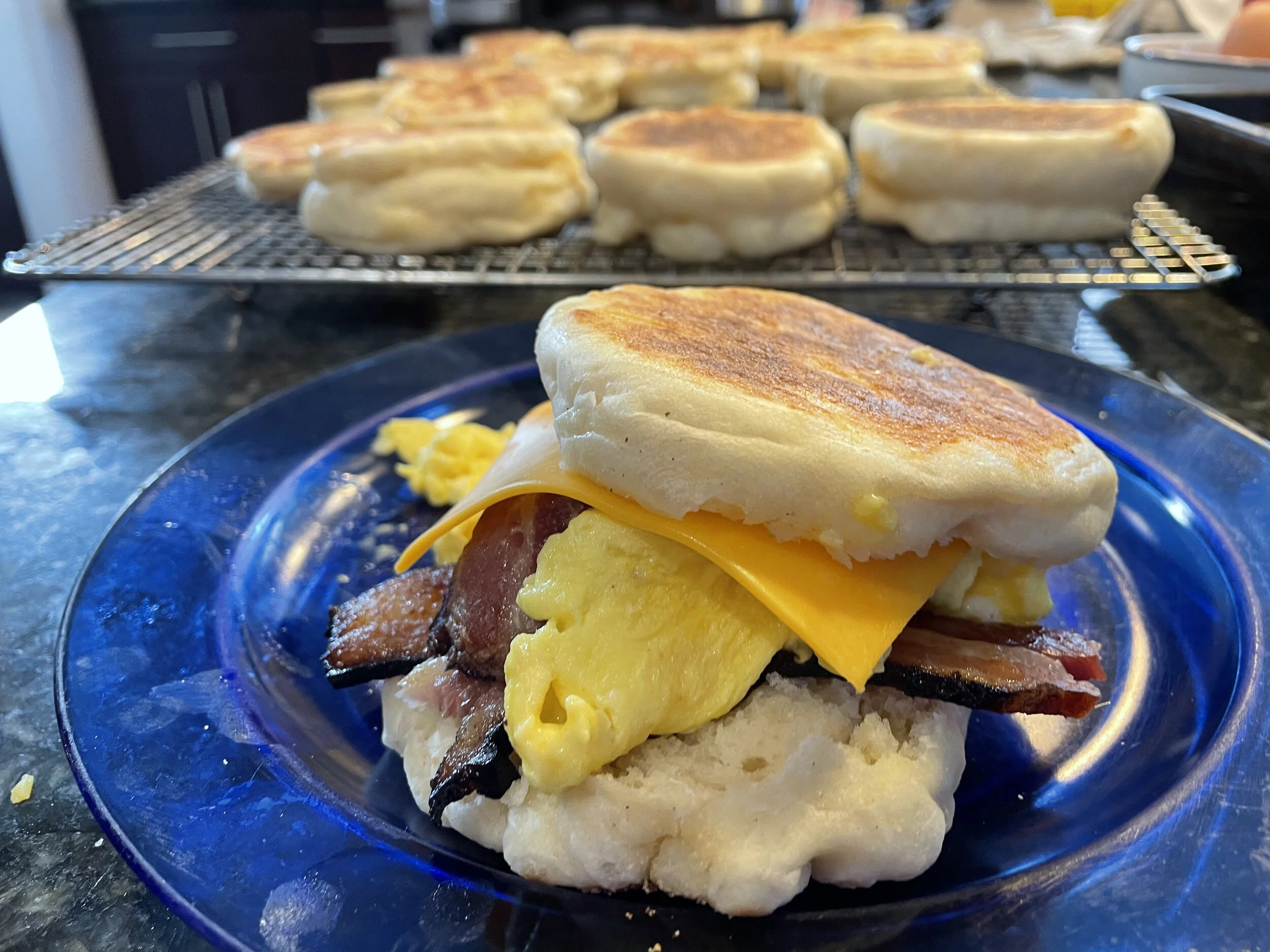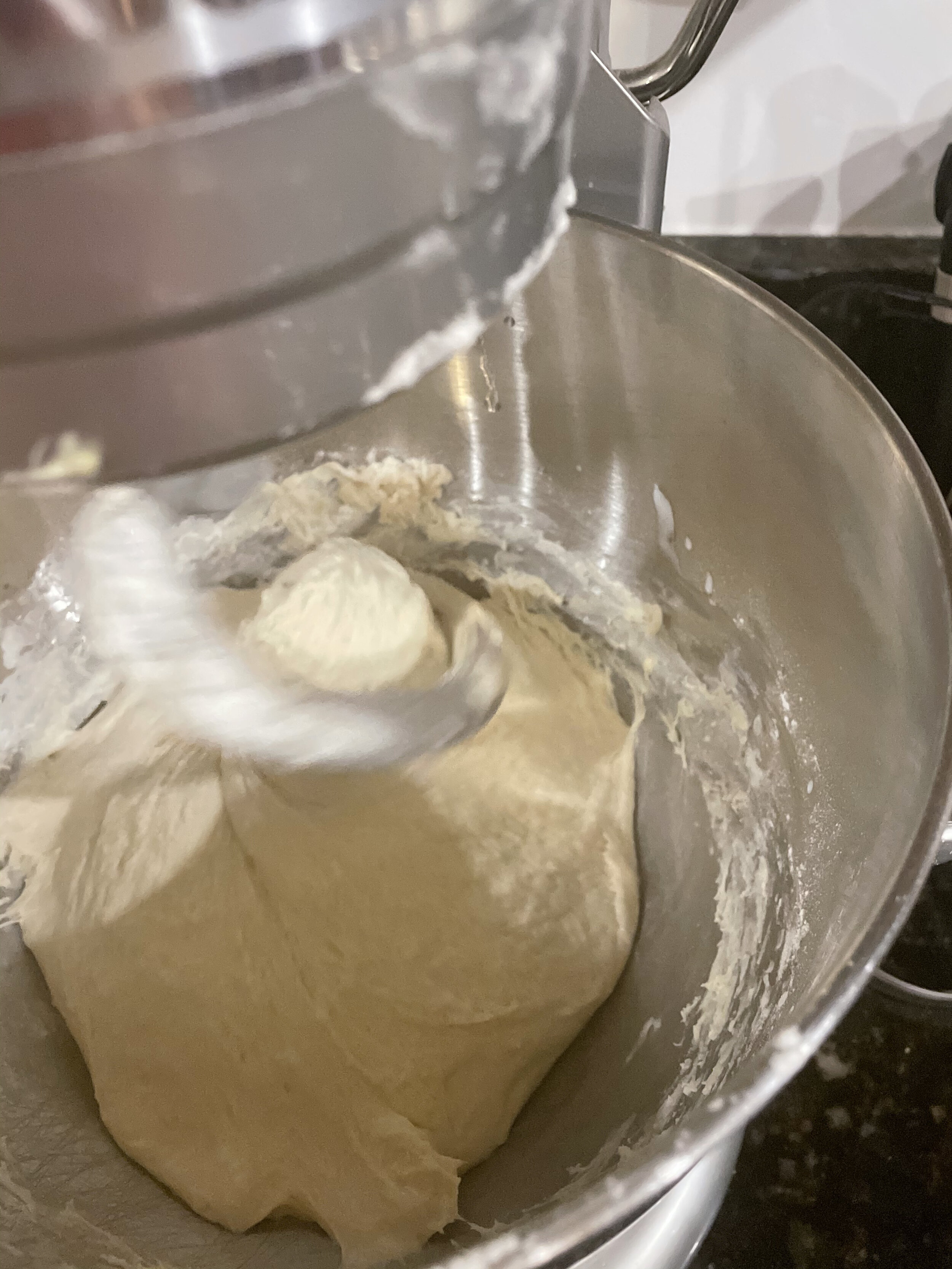English Muffins
Nuts and Bolts:
English Muffins are one of my favorite bread recipes since it is simple and foolproof. It is taken from Bon Appetit Magazine. This recipe produces a very forgiving dough that you can use either bread flour or all-purpose flour, and you will get tasty muffins. I feel it is foolproof because it is hard to undercook these muffins. Since this recipe uses both cooking on a griddle and finishing the muffins in the oven, they turn out perfectly. I make them often, and I use them to make one of my favorite breakfast, the egg sandwich.
My thoughts on English Muffins:
It is a straightforward recipe. So I make two recipes at a time. It does not doubt well.
You can use either bread flour or all-purpose flour. The only difference is that nooks and crannies are less defined. But they still taste lovely.
It is a two-day bake.
They store well in an air-tight container for a week, but they freeze well. They can last a couple of months in the freezer. You will never buy English Muffins for your mess again.
Method:
Day one:
Although I like to start this recipe in the evening, it can be started at any time of day. The longer a dough proofs in the fridge, the more flavorful the muffins will be. To make English muffins, you will need; yeast, sugar, warm water, room temperature buttermilk, room temperature butter, vegetable oil, salt, bread flour, nonstick vegetable oil spray, and cornmeal.
Important tip: I use a lot of nonstick vegetable oil spray (Pam) in this recipe because this dough is very tacky. So to work this dough, you will use a lot more spray than you think you need. This is the only tricky bit of this recipe because it can stick to everything, including parchment paper.
Here is the yeast mixture foaming and is ready to be mixed with the other ingredients.
First, I spray a large bowl liberally with nonstick vegetable oil and set it aside. Then I add warm water, sugar, and yeast in a mixer bowl with the dough hook attachment on the mixer, lightly mix, and then let it sit for five minutes. While the yeast is proofing, I warm the buttermilk in the microwave for thirty seconds. After waiting five minutes, the yeast mixture starts to foam, and then I add the buttermilk, butter, oil to it and mix to combine. Then I slowly add some flour, then salt, and followed by the rest of the flour. Then increase the speed of the mixer to medium. I let the machine knead for five minutes or until the dough pulls away from the bowl. The dough can be wet and sticky. After doing that, I transfer the dough to the prepared bowl, then cover it and place it in the fridge overnight.
The dough here is pulling away from the sides of the bowl and is ready to be transferred to the prepared bowl for proofing.
Day two:
I cover a rimmed baking sheet with parchment paper and cornmeal. Gently try not to deflate the dough; place it onto a floured surface to be cut and shaped into the muffins. This recipe should make about a dozen muffins. Each dough ball should weigh about 3 ounces. So, I get out my scale, use a piece of plastic wrap sprayed with nonstick vegetable oil spray, and put it on the scale to weigh each dough ball. Then push the ends of the ball until it becomes like a balloon.
Important tip: Shaping of these is not that important. I make mine freestyle, so sometimes my English Muffins look like a Matisse paper cut-out. They are hard to shape because they can be so sticky. Also, if using all-purpose flour, they are even tackier and are harder to form. So just try your best. They will taste great anyway!
Then place the dough ball on the prepared cookie sheet. When all the dough balls have been shaped and placed on the tray, spray a large piece of plastic wrap with nonstick vegetable oil spray and then cover the formed dough balls with the prepared plastic wrap and let them rise for 60-70 minutes.
Here is the process of shaping the English Muffins. Tops left is the beautifully risen dough. The top right is my set-up to cut, weigh, and shape the dough. Lower Left is the dough being weighed, and the lower left is the shaped dough on its second rise.
I place a cookie sheet in the oven and preheat the oven to 350°F. Also, I heat a griddle that is lightly oiled. When the dough is finished rising, you can use English muffin rings for perfect round muffins, but I prefer free form. When I start cooking the muffins, I drop just a couple of dough balls on the griddle to see how hot the pan is. Let it cook for two to three minutes a side. They should be golden brown to dark brown. Then, I place them on the preheated cookie sheet in the oven and bake from 5-7 minutes. Repeat until all the dough has been cooked. Then let cool, toast, and enjoy.
On the left are the English muffins cooking on their first side, and on the right, the English muffins flipped to the second side.
Final thoughts:
I make English Muffins regularly. They are easy to make even though the recipe seems complicated. These muffins make great egg sandwiches, and I have been known to make them so I can have egg sandwiches. So give these English Muffins a try in your mess.
Cooling English Muffins.
English Muffins:
INGREDIENTS
1 cup water, warm
2 1/4teaspoons active dry yeast or 1 1⁄4-ounce envelope active dry yeast
1 tablespoon sugar
1 cup buttermilk, warmed
4 tablespoons (1⁄2 stick) unsalted butter, room temperature
2 tablespoons vegetable oil
2 teaspoons kosher salt
3 1/2 cups unbleached bread flour, divided, plus more for dusting
Nonstick vegetable oil spray
Cornmeal (for dusting)
Directions:
Day One:
First, spray a large bowl liberally with Nonstick vegetable oil spray and set it aside. Then add warm water, sugar, and yeast in a bowl with the hook attachment on the mixer, lightly mix, and then let it sit for five minutes. Warm the buttermilk in the microwave for thirty seconds. After five minutes, you should see the yeast mixture start to foam and then add the buttermilk, butter, oil to it and combine. Then slowly add some flour, then salt, and followed by the rest of the flour. Then increase the speed of the mixer to medium. Let the machine knead for five minutes or until the dough pulls away from the bowl. The dough can be wet and sticky. Then transfer the dough to the prepared bowl. Then cover it and place it in the fridge overnight.
Day two:
Cover a rimmed baking sheet with parchment paper and cornmeal. Gently trying not to deflate the dough, place it onto a floured surface to be cut and shaped into the muffins. This recipe should make about a dozen muffins. Each dough ball should weigh about 3 ounces. Then push the ends of the ball, so it gets to round like a balloon. Then place the dough ball on the prepared cookie sheet. When all the dough balls have been shaped and placed on the tray, spray a large piece of plastic wrap with nonstick vegetable oil spray and then cover the formed dough balls with the prepared plastic wrap and let them rise for 60-70 minutes.
Place a cookie sheet in the oven and preheat the oven to 350°F. Also, heat a griddle that is lightly oiled. When the dough is finished rising, drop a few of the formed dough balls on the hot griddle. Let it cook for two to three minutes a side. They should be golden brown to dark brown. Then place the muffins on the preheated cookie sheet in the oven and bake from 5-7 minutes. Let them cool on a rack. Repeat until all the dough has been cooked.








